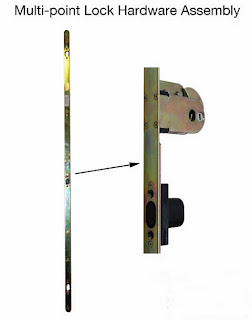Multi-Point locking mechanisms used on sliding patio doors have been manufactured by Truth, Marvin, Fuhr, Hoppe or a half dozen others. When the door is fully closed, the thumb turn latches at two, three or more points into or around keepers in the jamb.
Fifty percent of the time, maintenance issues with these high-security style locks can be contributed to the keepers, which may just be out of adjustment or alignment.
With these designs, the thumb turn cannot move the latches until the door is completely closed and a "plunger", protruding from the jam, presses against a "trap door" on the face of the mechanism, which releases the latches to move into place... thus, locking the door.
Or, with some manufacturers, the door handle needs to be held down as the door is closed in order to release the latches... and, then the latches can engage the keepers when the handle is released.
The other half of the time, maintenance issues are the result of bent latches or components internal to the locking mechanism. This usually happens when someone has tried to adjust the keepers or they gradually moved out of adjustment over the years. When the person closed the door and twisted the thumb turn to move the latches, the latches did not fully catch the keepers. Then, opening the door without twisting the thumb turn back to return the latches to the open positions, the door was closed again and the keepers hit and bent the mechanism which was still in the closed position.
You can take the entire mechanism apart and play with it for a couple of hours and you might be able to straighten out the bent components. But, you are better off just buying a whole new mechanism for a few hundred bucks.
Note: When ordering a new multi-point mechanism, you will need to measure the length, width, offset and possibly several other dimensions. The right one is not hard to find on the Internet.
Replacement of the entire mechanism can take less than one half hour and adjusting the keepers can take up to another half hour. Suggestion: Remove the keepers and then replace individually to adjust them one at a time.
Friday, December 27, 2013
Thursday, December 19, 2013
WINTER WEATHERSEAL
If you are feeling a draft from under your sliding patio door on those icy winter nights, it is likely that your weatherseal has worn away or been stolen by gremlins.
The solution can be as simple as replacing the weatherseal for less money than it is costing you in heating bills each year.
Here are two images of work that was done to replace old defective rollers and missing weatherseal.
BEFORE
AFTER
The solution can be as simple as replacing the weatherseal for less money than it is costing you in heating bills each year.
Here are two images of work that was done to replace old defective rollers and missing weatherseal.
BEFORE
AFTER
Thursday, December 5, 2013
YOUR PSYCHIC HANDLE...
YOUR HANDLE KNOWS...
90% of all sliding patio door handles are designed to only withstand the normal pressure of opening and closing the door when the door itself is in good operating condition.
A loose or broken handle is the first sign that something else is not right. If you replace the handle without determining the underlying cause, which is usually improving the ease at which your door moves, you will be buying another handle in the near future.
A few of the common handle designs can be found at your local home center and the other hundred styles are available to be ordered. Rarely are handles found to be obsolete. http://www.allaboutdoors.com/index.php?cPath=74_80&osCsid=937574de2dc41f93bf2bd7eafe30cce5
Most handles are secured by two or more mounting screws. The distance between the centers of these screw holes is an important factor in locating the correct part.
BROKEN LATCH LEVERS...
Most handles incorporate a latch lever or thumb turn that move the locking latch open and closed. When the door is rolled to the fully open position, no part of the handle should bump into anything.
A "bumper" (or two) is/are usually installed at the jamb or track to prevent the door from opening so far that the latch lever or handle will hit the frame of the stationary panel.
A latch lever or thumb turn should never require much force to move the latch mechanism. Don't force it.
90% of all sliding patio door handles are designed to only withstand the normal pressure of opening and closing the door when the door itself is in good operating condition.
A loose or broken handle is the first sign that something else is not right. If you replace the handle without determining the underlying cause, which is usually improving the ease at which your door moves, you will be buying another handle in the near future.
A few of the common handle designs can be found at your local home center and the other hundred styles are available to be ordered. Rarely are handles found to be obsolete. http://www.allaboutdoors.com/index.php?cPath=74_80&osCsid=937574de2dc41f93bf2bd7eafe30cce5
Most handles are secured by two or more mounting screws. The distance between the centers of these screw holes is an important factor in locating the correct part.
BROKEN LATCH LEVERS...
Most handles incorporate a latch lever or thumb turn that move the locking latch open and closed. When the door is rolled to the fully open position, no part of the handle should bump into anything.
A "bumper" (or two) is/are usually installed at the jamb or track to prevent the door from opening so far that the latch lever or handle will hit the frame of the stationary panel.
A latch lever or thumb turn should never require much force to move the latch mechanism. Don't force it.
Subscribe to:
Comments (Atom)



